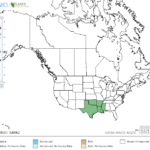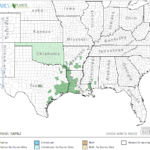Sagittaria papillosa
USDA, NRCS. 2018. The PLANTS Database (http://plants.usda.gov, 28 March 2018). National Plant Data Team, Greensboro, NC 27401-4901 USA.
What is Nipplebract Arrowhead?
Physical Characteristics
Leaves:
- Straight
- Blades linear to thinly sword-shaped
- Up to 10 inches long & 2 inches wide
Flowers:
- Sepals up to 0.23 inches long
- Petals about twice as long as the sepals
- Stamen smooth
- Linear filaments up to 0.06 inches long
- Head about 0.39 inches in diameter
- Blooms Apr – Oct
Fruit:
- One seeded
- Does not open to release seed when ripe
- Wedge-shaped
- Up to 0.06 inches long & 0.05 inches wide
Stem:
- Typically branching from the lowest whorl
- Main axis has up to 10 whorls
- Bracts oval-shaped, up to 0.39 inches long
Where Does it Grow?
Nipplebract arrowhead can be found in swamps, marshes, muddy areas, ditches, small ponds, and depressions in prairies.
Pros and Cons of Arrowhead
The tubers of arrowheads are prized foods by ducks, geese, muskrats, and nutria. Seeds are sometimes consumed by ducks. Submerged portions of all aquatic plants provide habitats for many micro and macro invertebrates. These invertebrates in turn are used as food by fish and other wildlife species (e.g. amphibians, reptiles, ducks, etc.). After aquatic plants die, their decomposition by bacteria and fungi provides food (called “detritus”) for many aquatic invertebrates.

